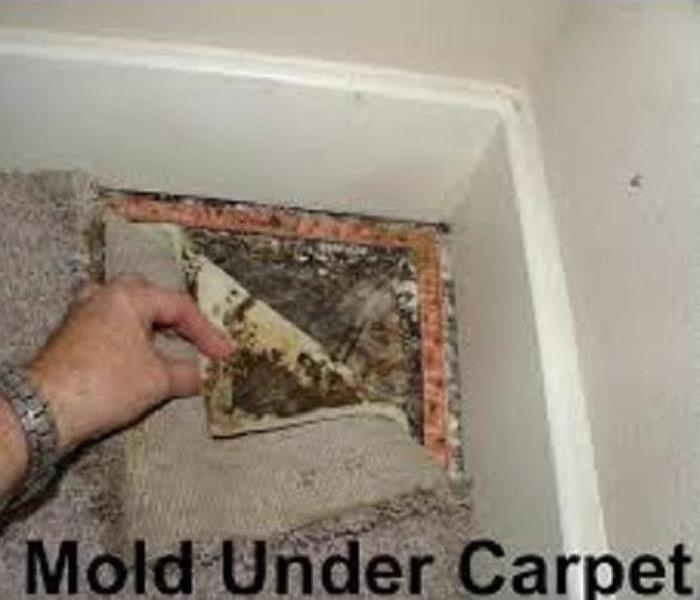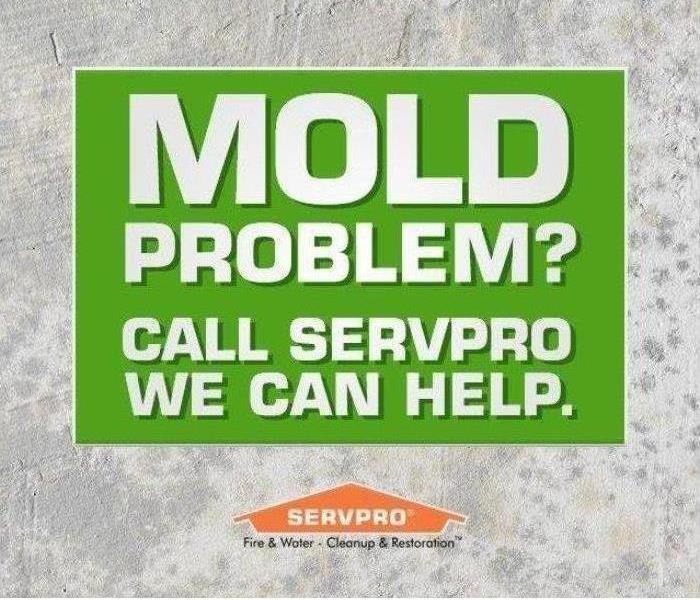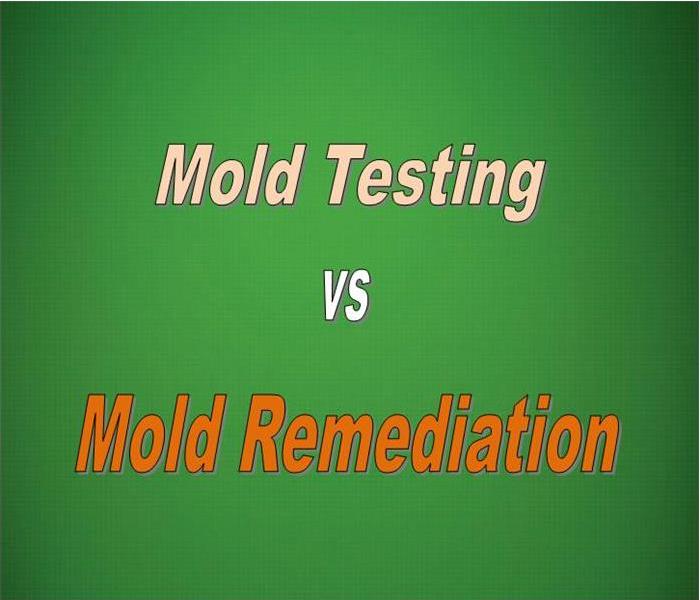Recent Mold Remediation Posts
Mold and Lake Homes
7/19/2019 (Permalink)
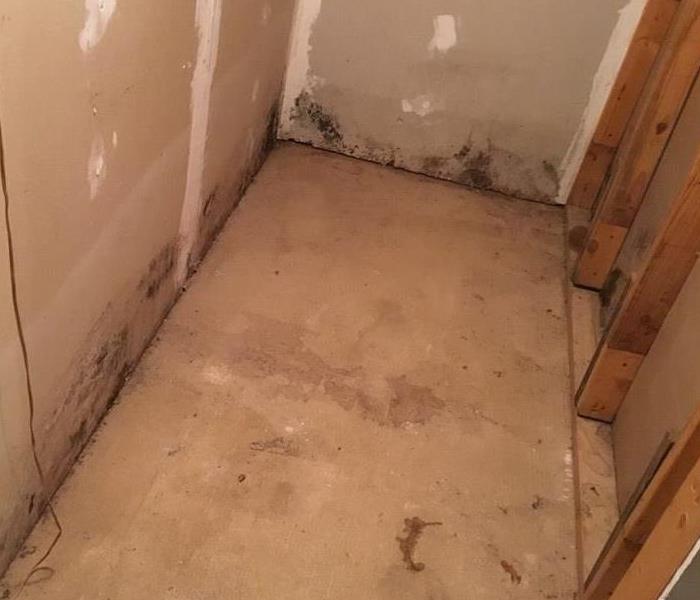 Mold found in closet of home
Mold found in closet of home
Mold and Lake Homes
When a building, such as a lake house, is closed up and has little to no ventilation, mold has the opportunity to grow and contaminate the structure. Mold is quick growing and can take hold in 47 hours. To prevent this mold growth, make sure that moisture and humidity is reduced as much as possible. In order for the mold to grow it takes a damp environment, so taking measures to control the humidity will control the growth. Consider taking the steps below to control mold issues and keep your homes environment from inviting mold to grow.
- Increase the ventilation in your home. Air movement reduces mold growth.
- Try running a fan or air conditioner when you are away.
- Leave interior doors open
- Have a dehumidifier in your home
- Remove all wet towels and wet clothing from home and dry outside
- Remove water from the toilet and bottom of dishwasher when leaving the home for an extended amount of time
- Make sure your gutters have been cleaned of debris
- Removing and cutting back on tree branches can allow the sun in
- It is also a good idea to make sure someone periodically checks on your Property so any issues can be addressed early on
Mold is a living organism that naturally exists in the outdoor environment. Mold ejects spores into the air. These spores are similar to plant seeds and will grow additional mold when and if these spores land upon an area which provides moisture and a suitable food source. While Mold can be a cause for concern, following the preventative measures listed above can ensure your property is suitable for occupancy.
Non-porous items like metal, concrete, countertops, appliances, and decking can be cleaned with an eco-friendly product. When items such as carpets, upholstery, ceiling tiles, mattresses and dry wall become invaded with mold they will need to be discarded of.
If you return to your lake home and find yourself with a mold issue call SERVPRO of the Quad Cities for an inspection and moisture check. Our technicians are highly trained in Mold Remediation.
Prevent Moldy Carpet
1/23/2019 (Permalink)
Mold can grow in virtually every area of a home and on any surface, if given the right environment. That includes your beautiful carpets that you spend so much energy trying to keep clean and looking beautiful. While there can be many causes of mold in a home, when it comes to moldy carpets there are a few things you can do to reduce the chances you ever have to deal with it.
Control the humidity and temperature in your home
Mold grows best with a certain amount of moisture in the air as well as certain temperature ranges. One way to help prevent mold growth on any surface in your home, including your carpets, is to ensure your humidity levels never reach 60%. And while it’s unlikely you like living in this warm of a house, make sure you don’t set the thermometer above 80 degrees.
Consider a different floor covering in areas prone to moisture
Some areas of a home are just more prone to humidity and moisture. Like your bathroom, for instance. Every design aspect of your home should be done with appearance and functionality in mind, and that includes making sure you’re making smart decisions about the type of floor coverings to have in certain areas based on the area’s usage along with environmental aspects. When it comes to bathroom floors, and to a lesser extent basement floors, sometimes the smartest plan is to avoid carpets altogether.
Use carpet padding that is anti-microbial
There are a few different types of padding most commonly used in residential homes. While some are more budget friendly than others, if you’re considering carpet in areas that may be more prone to moisture issues, consider installing rubber-slab carpet padding. It’s much more resistant to mold growth than traditional carpet pads.
If you do get standing water on your carpets, get it out fast!
This goes for any surface type in your home, and it’s especially true with carpets. With the right humidity levels and temperatures, mold growth can accelerate quickly when food and water are present. Getting the water and excess moisture out quickly can be the difference between a close call and a serious health problem for your family.
Clean your carpets regularly
Vacuuming your carpets regularly, along with having them professionally steam cleaned, can go a long way in preventing mold growth. One of the components of rapid mold growth is food, and mold loves dirt, grime, food, and any other organic substance that can be found in your carpet fibers. Regularly cleaning your carpets is a great way to help reduce the likelihood of dealing with mold in the future!
Typically, if you have mold on your carpets a visual inspection is all that is necessary. But in other instances, you may notice a musty smell or perhaps you’ve also been experiencing some troubling health issues that you think may be attributed to high levels of mold. Call SERVPRO of the Quad Cities at 256-383-4470 if you think you may have a mold problem in your home.
The Correct Way to Handle Mold Damage
12/9/2018 (Permalink)
In Florence, mold damage is a common problem. It affects all kinds of homes and businesses. It is not something to be scared of; it happens to almost everybody, at some time in their lives. However, it does need to be treated with caution. Mold damage, though common, can be both expensive and can cause health effects.
This is why the only effective solution for dealing with chronic mold damage in Florence is to call in the experts. Qualified mold damage restoration teams have the necessary skills and expertise to make sure that all of the damaged areas of a property are safely removed. If you do not seek professional advice, you risk the problem becoming a recurring one.
This guide to the importance of professional mold damage restoration will help you get to grips with the best possible solution.
Fix the Source of the Issue
While homeowners can go some way to removing the superficial signs of mold damage (visible marks and blemishes), it is much more difficult to pinpoint the cause. And this is vital if the problem is to be eradicated for good. Mold damage restoration experts are trained to look for patterns and uncover the source of the destruction. More often than not, the mold is being caused by an unidentified leak within the building or humidity issues.
Recognize the Type of Mold
It is a common misunderstanding to assume that all mold is the same. In fact, there are more than 10,000 different varieties. As they all require a slightly different approach, identification is key to tackling mold damage. Nobody expects you to be able to distinguish between the characteristics of a thousand mold samples, so take the job to somebody who is specially trained for it.
Use the Right Equipment
Another important benefit of using a professional mold damage restoration service is access to specialized equipment. You might have a basic dehumidifier in your home or workplace, but this won’t be strong enough to tackle a serious problem. If there is evidence of high level mold in the building – which causes negative health effects – protective clothing is needed to ensure safety.
Water Damage Can Cause Mold Growth
12/3/2018 (Permalink)
Did You Know?
Water damages can cause mold growth in your home or business; therefore, it is important to have your water damage cleaned promptly and professionally.
Signs of the presences of excessive mold include:
- Visible mold
- Strong, musty odors
- Excessive humidity in your home or office
Mold is most likely to occur in the following areas:
- Dark spaces that receive very little light
- Spaces already predisposed to high levels of humidity such as in your bathroom
If you have any of these signs of mold, then call us immediately and we can access the damage. We are here to promptly clean-up any water damage that you may have from a leaking roof to a completely flooded home. Call us today at (256) 383-4470 to prevent water from turning into mold growth.
Water Leaks Can Cause Mold
9/18/2018 (Permalink)
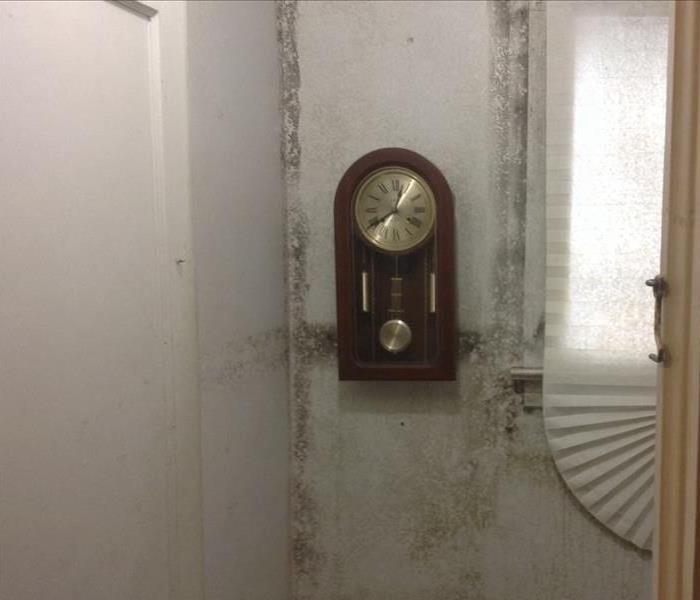 Mold grows on basement wall of a home in Muscle Shoals.
Mold grows on basement wall of a home in Muscle Shoals.
Water Leaks Can Cause Mold
A leaky faucet in your home can be very annoying, but it has the potential to be much more than an annoyance. The moisture caused by leaks can make your home into the perfect environment for mold growth. Mold spores may cause adverse health effects and can grow rapidly if you fail to notice a leak shortly after it starts, especially in humid climates like we have here in Florence. Knowing the risks that mold presents and quickly fixing your water leaks can help to protect your home from mold growth.
About Mold Growth
Mold growth will begin in areas of your home that are wet. The mold spores will land on moist surfaces and then start to germinate. The materials on which mold can grow include:
• Sheetrock
• Tile
• Painted surfaces
• Carpet
• Wood
Indications of Mold Growth Due to Water Leaks
If you see black and white spots in the area of the leak, this is a sign that you have mold. Kitchens and basements are some of the areas in your home where there is a high risk of mold growth as these areas are prone to leaks. It is therefore important that you properly maintain your plumbing fixtures.
Get Professional Assistance
If there is a part of your home that is prone to water leaks, contact a plumber. If there are hidden problems that are causing leaks to recur, you may not be able to find them yourself. A licensed plumber who is experienced at finding and fixing leaks will be better able to find and fix the issues. Your plumber will also be able to advise you on how to maintain your plumbing to prevent water leaks and mold growth in the future.
Is Mold Hiding In Your Home?
8/28/2018 (Permalink)
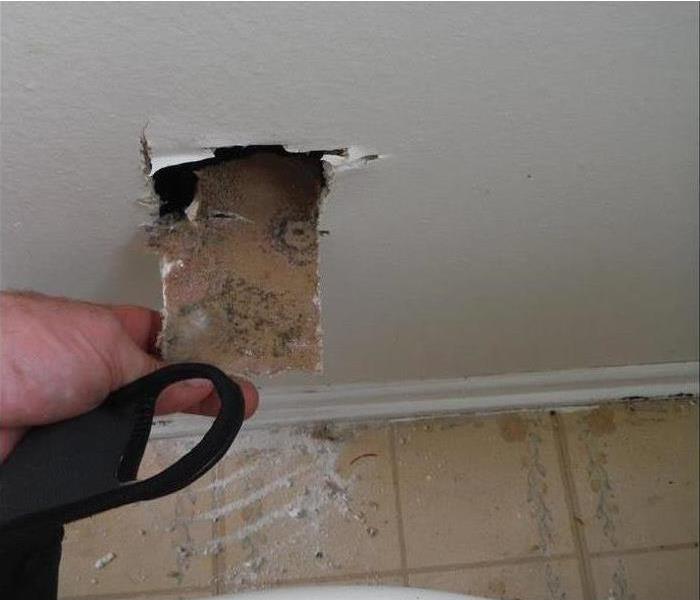 We understand mold and mold growth and have the training and expertise to remediate the mold in your home or business.
We understand mold and mold growth and have the training and expertise to remediate the mold in your home or business.
Mold spores are constantly floating through the air. Once they land, growth can get out of control. Unfortunately, many strains in Florence, AL become problematic once colonies are established. It doesn’t always present itself in plain view. These are three common places mold growth can occur out of sight in your home.
1. Walls
Mold can be sneaky when it comes to walls. It often lurks behind them where it grows undisturbed outside of view. A musty smell is usually the only clue. Wallpaper can provide refuge for it as well, hiding moldy drywall beneath it. If wallpaper is wet and peeling, there is a chance of hidden fungus beneath. Attempts at self-removal could release more spores into the air and worsen the infestation.
2. Flooring
Another place mold lurks is under flooring. Carpets are porous, and mold loves to hide underneath them. After a leak or large spill, mold can establish itself in the carpet pads. Mold on wood floors underneath carpets is common. It can also hide beneath linoleum. Sometimes the linoleum is curled, or there is fungus on the baseboards that gives a clue to mold growth underneath.
3. Sinks
Anywhere there is water, there may be mold. A common place to find water is in sinks, but the sink itself is not the only place mold resides. Homeowners need to look beneath sinks as well. The pipes underneath sinks can leak and cause a big mold problem in the surrounding cabinets. If not checked regularly, growth can go undetected and get out of control quickly.
Mold growth can be found in all sorts of hidden places from the walls to the floor. It is best to call a remediation professional in these tricky situations. With the help of a specialist, even hidden growth can be found and banished to make for a healthier home.
Visit http://www.SERVPROthequadcities.com for more information on mold.
Mold Remediation And Mold Testing In Florence
7/24/2018 (Permalink)
You would think a company that does mold remediation would also do the testing of mold, right? Well, SERVPRO does not and here are our reasons why.
Given that we are a Cleaning and Remediation Company, we have determined that being certified to be an Industrial Hygienist (IH) is veering too far from our profession. Mold remediation and mold testing require different sets of training, certifications, and professional equipment. For remediation purposes, the Institute of Inspection Cleaning and Restoration Certification (IICRC) offers a course called, Applied Microbial Remediation Technician (AMRT). In this course technicians learn how to properly remediate mold, but not test for it. For testing purposes, you must have a 4 year bachelor’s degree in the particular field as well as specific IH courses. Click here for more about becoming an Industrial Hygienist.
In addition, a company that does both testing and remediation of mold could potentially appear to be skewing test results in order for their remediation to pass. To avoid this conflict of interest, we not only have another company do the testing but we also have the customer call in the IH rather than bringing them in ourselves as a subcontractor of our services. This ensures that the IH is working for the customer’s best interest.
So where do you start?
If you believe that you have a mold problem your first step is to find the source and stop it. Next, we would recommend that you call in an Industrial Hygienist to come out and test the area. A protocol will be written based off of the testing and, if you do indeed have a substantial amount of mold present that needs to be remediated, that is where SERVPRO of the Quad Cities comes in. With the protocol in hand, we are able to properly assess the area and determine the extent as well as type of cleaning that will be needed to get your home or business back to preloss condition.
If you have more questions give us a call 256-383-4470.
How Often Do You Inspect Your Crawlspace?
1/24/2018 (Permalink)
When was the last time you poked around in your crawlspace? Likely it was directly related to something going wrong, unless you also use this space for storage. So who is maintaining your crawlspace? Keeping an eye on things? Making sure it stays clean and dry?
If you are like most of the Shoals area home and business owners that we at SERVPRO of the Quad Cities come in contact with, you likely answered "no one" for most if not all of these questions. That is why we often get the call once some sort of issue causes you to explore your crawlspace - such as a leak - only to find that it is now full of mold!
If you find mold, mildew, or any kind of microbial growth in your crawlspace, call us! SERVPRO of the Quad Cities has the training and resources to provide a comprehensive job scope to take care of the symptoms and the cause. We will remediate the existing mold and take preventative measures to keep it from coming back; all the while explaining to you the process, the products, and everything in between, so you know what is going on and are comfortable with the process.
Does Mold Grow During Winter?
12/10/2017 (Permalink)
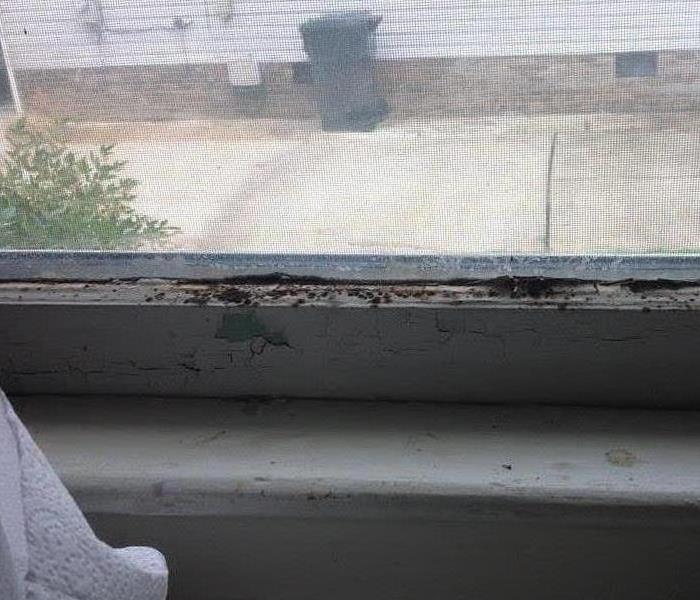 Mold grows anywhere it has a damp environment. While windows keep most moisture out of the house, their sills may have dampness from condensation.
Mold grows anywhere it has a damp environment. While windows keep most moisture out of the house, their sills may have dampness from condensation.
When temperatures start to drop, homeowners tend to stop worrying about mold and direct their attention toward household issues that are more commonly associated with cold weather. However, mold can develop in winter as well. While mold thrives in warm, humid environments, the primary contributor to mold growth is moisture, which can get out of hand at any time of year.
Excessive indoor moisture can be caused by a number of issues; water damage, plumbing leaks, leaky roofs, high indoor humidity, and condensation are potential concerns.
Condensation on and around windows, in particular, is normal and may seem harmless, but it is one of the biggest moisture culprits when it’s cold outside but warm inside—as is typically the case during winter.
Window condensation occurs when moisture in the warm air inside your home liquefies upon contact with glass or other surfaces that are drastically cooler due to freezing outdoor temperatures. High humidity contributes to this process because there is excess moisture in the air.
While minor condensation doesn’t usually lead to problems, it is important to dry window surfaces regularly to keep condensation from accumulating and being absorbed by the wood and drywall around the windows. Mold feeds on such organic materials and can develop in as little as 24 hours. Mold Prevent specializes in attic mold remediation.
If you are in need of mold removal services, SERVPRO of the Quad Cities can help!
Water And Mold Damage From a Roof Leak
12/4/2017 (Permalink)
 A roof leak caused water and mold damage to this home.
A roof leak caused water and mold damage to this home.
If you discover that your roof is leaking, it is extremely important to take prompt action to have it repaired. Not doing so may put your entire home at risk. A roof leak, even a minor one, could be an indicator of a much greater problem. Any size leak in your roof can cause a great deal of damage if it persists long enough. Make sure you do not let it continue once a leak is discovered.
Usually a roof leak will be noticed from the inside of the home when water rings or ceiling stains form on the ceiling. A leak can create an environment that can lead to ceiling instability, water intrusion through cracks or electrical receptacles, deterioration of the structure and even mold growth. Early detection and proactive maintenance can greatly reduce the damage and cost of these repairs. It may be difficult to readily identify the source of the water intrusion, which is why water rings or leaks should never be ignored.
Roofs are one of the biggest protectors of our home and over time they can become damaged due to bad weather, harsh climates and poor maintenance. The strength and longevity of a roof can also be compromised due to poor quality materials or improper installation so make sure you hire a professional company with experience who stands behind their work. When it comes to protecting your home, investing in quality materials and workmanship is always worth the cost!
Controlling A Mold Problem
9/19/2017 (Permalink)
Mold is often a problem after a water damage, especially one that wasn't handled professionally. Many homeowners try to handle water damage cleanup themselves and unseen damage leaves moisture that later causes mold to grow.
If you had a water damage recently and you now smell a musty odor or have visible mold, here are some tips from the Federal Emergency Management Agency (FEMA) to help control mold problems:
- The source of mold is moisture; therefore fix all leaks in pipes and in any damp area around tubs and sinks.
- Rebuild, or retrofit, with water-resistant building materials such as tile, stone, deep-sealed concrete, galvanized or stainless steel hardware, indoor/outdoor carpeting, waterproof wallboard and water-resistant glues.
- Prevent seepage of water from outdoors into your house. It is important to have rainwater from gutters or roof drains away from the structure. Ground around the house should slope away to keep basements and crawl spaces dry.
- Cover dirt in crawl spaces with plastic to prevent moisture from coming up from the ground. Ventilate the area as much as possible.
- Clean fabrics such as curtains and upholstery often to keep them dry, because soil promotes mold growth.
- Consider having ductwork cleaned and inspected professionally or replaced if you suspect mold exists on the inside surface of the duct or if duct insulation has been wet.
- Reduce the moisture in the air with dehumidifiers, fans and open windows or air conditioners.
- Do not use fans or vacuum cleaners if mold already exists, especially in hot weather. A fan or vacuum cleaner will spread the mold spores.
- In moisture-prone areas, choose carpets of man-made fibers.
- Reduce potential for condensation on cold surfaces by insulating.
- Routinely check potential problem spots.
For more information, visit www.fema.gov/removing-mold-your-home.
Crawlspace Moisture And Mold
8/29/2017 (Permalink)
 Mold in the crawlspace of a Florence home after a water leak
Mold in the crawlspace of a Florence home after a water leak
Do you have problems with moisture in your crawlspace? Has a water leak caused mold, mildew or wood rot?
Call SERVPRO of the Quad Cities and we can handle that for you. Our trained and certified mold remediation technicians can diagnose your crawlspace moisture problem and get your crawlspace dried out in no time. Our technicians will remove any wet insulation in your crawlspace, treat the mold and mildew with an anti microbial solution, dry the wet floor joists or subfloor, and remove and reset the vapor barrier so that you have no more problems of moisture damaging your home environment.
If you have a mold problem in your home or business, consider the following facts:
- Significant mold growth can occur in 48-72 hours.
- Mold may present a greater risk to children, the elderly, and anyone with respiratory problems.
- A strong, musty odor may indicate hidden mold behind drywall or under carpeting.
What to Do:
- Stay out of affected areas.
- Turn off the HVAC system and fans.
- Contact SERVPRO of the Quad Cities for mold remediation services.
What Not to Do:
- Don’t touch or disturb the mold.
- Don’t blow air across any surfaces with visible or suspected mold growth.
- Don’t attempt to dry the area yourself.
- Don’t spray bleach or other disinfectants on the mold.
Don’t forget to call your local SERVPRO franchise at (256) 383-4470 to get a free estimate!
Does Your Florence Home Have A Mold Problem?
7/24/2017 (Permalink)
 In Florence, mold can spread through a home in as little as 48 hours.
In Florence, mold can spread through a home in as little as 48 hours.
Microscopic mold spores naturally occur almost everywhere, both outdoors and indoors. This makes it impossible to remove all mold from a home or business. Therefore, mold remediation reduces the mold spore count back to its natural or baseline level. Some restoration businesses advertise “mold removal” and even guarantee to remove all mold, which is a fallacy. Consider the following mold facts:
- Mold is present almost everywhere, indoors and outdoors.
- Mold spores are microscopic and float along in the air and may enter your home through windows, doors, or AC/heating systems or even hitch a ride indoors on your clothing or a pet.
- Mold spores thrive on moisture. Mold spores can quickly grow into colonies when exposed to water. These colonies may produce allergens and irritants.
- Before mold remediation can begin, any sources of water or moisture must be addressed. Otherwise, the mold may return.
- Mold often produces a strong, musty odor and can lead you to possible mold problem areas.
- Even higher-than-normal indoor humidity can support mold growth. Keep indoor humidity below 45 percent.
If your home or business has a mold problem, we can inspect and assess your property and use our specialized training, equipment, and expertise to remediate your mold infestation.
If You See Signs of Mold, Call Us Today – 256-383-4470
Mold and the Precautions to Take
1/26/2017 (Permalink)
SERVPRO® of the Quad Cities handles water damages every day and know prompt action is required to prevent mold growth. Mold is more likely to spread when an environment has been subject to moisture for a long period of time. If your property has sustained a recent water damage, it is important to be alert for:
- The presence of visible mold
-Strong musty odors which may indicate mold is present
- Any evidence of past moisture problems that might have caused undetected mold growth.
- Excessive humidity
These conditions may require the expertise of a qualified Indoor Air Quality Environmental Professional to inspect the building for mold growth.
Some amount of mold spores are normally present in most environments. If the humidity and moisture levels in a water damaged environment are not promptly returned to normal, mold spores may grow and multiply. Organic materials found inside a building, such as wood, paper, drywall and insulation, provide food sources for mold to flourish. Excessive mold growth can lead to indoor environmental conditions that pose a heath threat.






 24/7 Emergency Service
24/7 Emergency Service

